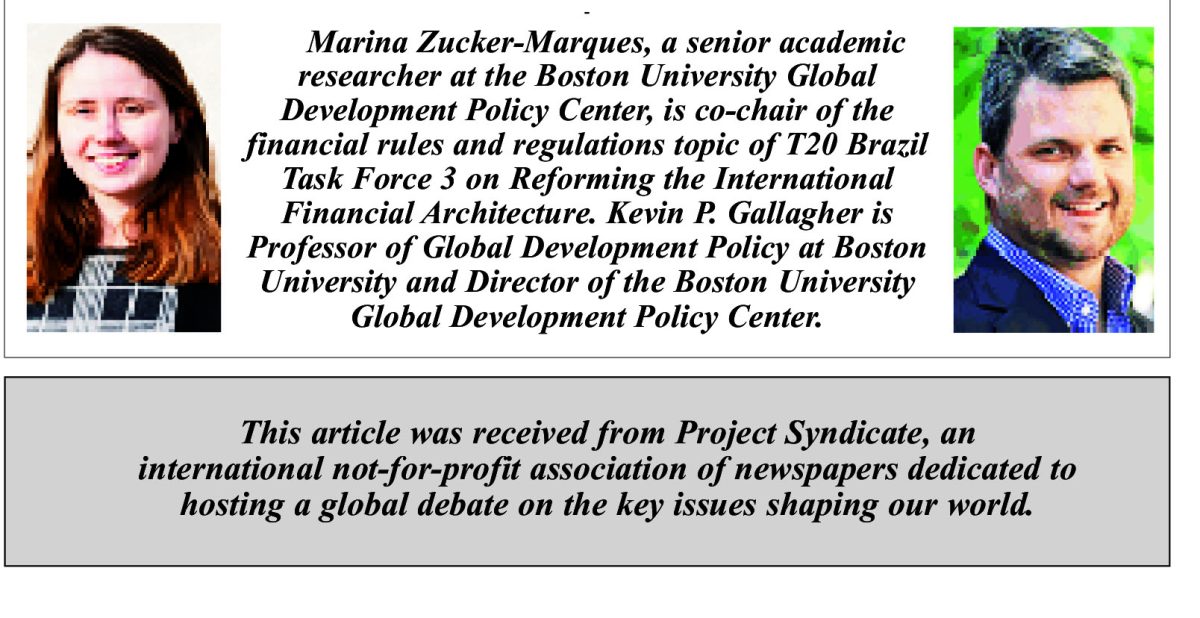 By Marina Zucker-Marques and Kevin P. Gallagher
By Marina Zucker-Marques and Kevin P. Gallagher
BOSTON – It is now conventional wisdom that global capital flows to the developing world are pro-cyclical, increasing when advanced economies ease monetary policy and retreating when their interest rates rise. A case in point is the growing number of developing countries experiencing liquidity and solvency crises in the wake of the recent tightening cycle, which began in 2022. According to the United Nations, 25 governments now spend more than one-fifth of their revenue on debt service – the highest number since the mammoth debt crisis of the 1980s and 1990s. Interest payments now exceed spending on education or health in countries where 3.3 billion people live.
The Bretton Woods institutions were established 80 years ago precisely to support developing countries with counter-cyclical public financing when the private sector cuts back on investment. The International Monetary Fund was intended to help with short-term liquidity, while the World Bank was supposed to focus on funding long-term growth and facilitating structural change to prevent liquidity crunches.
These institutions still exist, of course, but they are out of step with global economic realities. The world’s financial firefighters – the IMF, the World Bank, and other multilateral development banks (MDBs) – are trying to extinguish conflagrations in developing countries with buckets rather than hoses.
To ensure adequate liquidity for emerging market and developing economies (EMDEs), the international financial architecture must be transformed to make the IMF, the World Bank, and other multilateral institutions larger, more equitable, and less focused on austerity. There should be coordinated regulations to direct private capital toward productive growth and structural change in EMDEs during booms, and incentives to keep capital in these countries during busts.
Net transfers to EMDEs, excluding China, turned negative in 2022, meaning that debt-servicing costs exceeded new disbursements. This gap was particularly noticeable with regard to commercial banks and bondholders, reaching $193 billion in 2023. While the IMF and MDBs could offset private-sector withdrawals, non-concessional finance was negative, at -$2.7 billion, and concessional funding was positive but insufficient, reaching only $20 billion in 2023.
Even though IMF programs have increased in size by a factor of four since the 2008 global financial crisis, the adequacy of Fund resources remains below historical levels. The recent 16th General Review of Quotas, which concluded in December 2023, resulted in no net increase in the IMF’s lending capacity.
While advanced economies have access to a network of unlimited currency swaps, most EMDEs can turn only to the IMF for liquidity support. This worsens the inequality of the global financial safety net, the source of emergency finance comprising the IMF, regional financing arrangements, and central-bank swaps. To compensate such global inequality, the IMF – the only global institution in the GFSN – would need to increase lending capacity from roughly $500 billion to $1 trillion.
As for MDBs, they currently provide loans equivalent to just 0.5% of developing countries’ gross national income, down from a peak of 0.7% in the 1990s. According to recent estimates by the G20’s Independent Expert Group, MDBs must triple their financing by 2030 to achieve shared climate and development goals.
Moreover, IMF programs often impose stringent conditions on countries, forcing them to embrace austerity measures. The myth of the “confidence fairy” – the belief that austerity will restore market confidence and boost economic growth – refuses to die, despite many studies showing that IMF loan conditions increase poverty, inequality, and social unrest, rather than improving economic stability. World Bank financing has likewise been found not to promote growth.
The recent social upheaval in Kenya is a prime example. Despite hopes that IMF and World Bank loans would encourage private-sector refinancing, new bond issuances carried an exorbitant interest rate of 10.375%, exacerbating debt vulnerabilities. The Kenyan government’s recently proposed finance bill, which contained tax increases to meet IMF revenue targets, sparked protests that ultimately led to at least 39 deaths.
Financially distressed developing countries need a growth-focused approach that stabilizes the economy without cutting essential public spending. Homi Kharas and Charlotte Rivard of the Brookings Institution found that stimulus packages would lead to higher growth and shift EMDEs away from the structural patterns that trigger liquidity crises. After all, that is how advanced economies deal with shocks. The United States’ fiscal response to the COVID-19 pandemic, for example, totaled more than 25% of GDP, even with a debt-to-GDP ratio exceeding 120%. By contrast, Sub-Saharan Africa, with a debt-to-GDP ratio of 58%, could afford a pandemic response that was only 3% of GDP and is now struggling with repayment obligations.
The global financial system must allow EMDEs to implement counter-cyclical policies without austerity, or else the current crisis could very well end in massive debt relief, outright default, or widespread social unrest. Advanced economies must capitalize MDBs and help increase their efficiency, replenish concessional funds like the International Development Association, and increase financing for the IMF. The Fund, for its part, should overhaul its use of conditionality and issue a new round of Special Drawing Rights, its reserve asset.
The health of the world economy, and the livelihoods of billions of people, depend on bigger and better financial firefighters. If their capacity remains constrained, the legitimacy of the Bretton Woods institutions will weaken, and progress on global challenges such as climate change will remain elusive.
Copyright: Project Syndicate, 2024.

